
I went down to FSI today to do a couple of talks. I spoke first at the Portuguese Department about Brazil. This is probably that last time I will give a full-out lecture in Portuguese. My audience was colleagues almost done with their Portuguese language studies and about to go on their assignments. The other talk I gave was to PAOs headed out to their first posts as PAOs. I tried to give realistic advice, with the caveat that my experience should be taken in the context of Brazil, which is special.

FSI has changed and improved. They have created nice environmental spots you can see in the photos with lots of tall grass and natural looking rain gardens. I liked the cedar meadow. This would be typical of an old farm field in Northern or Central Virginia in the early stages of natural succession. This is one of my favorite stages, so full of dynamism and potential. I really don’t much like manicured lawns and I am pleased – maybe a little surprised that State Department has adopted the more raggedly natural approach.
I rode my old bike down to FSI. It feels off balance, but I will get used to it again. It is faster than my bike in Brazil and comfortable. In fact, of all the bikes I have ever owned, this one remains my favorite. I bought it back in 1997 and put more miles on this bike than any other, mostly on the same W&OD bike trail. I look forward to many more miles.
BTW – W&OD has also improved. They now have signs on the road and cars are stopping at the crosswalks.
Last time in Recife

This is a little late. I did my last visit to my erstwhile post in Recife last week. I visited Recife only three times. It was not like São Paulo or Rio that constantly called for attention.

One of my goals in Brazil was to get away from the big cities of Rio, São Paulo and Brasília into the rest of Brazil. I will not say the “real” Brazil, since there is no such thing. Each section is real in its own way. São Paulo probably has the biggest claim to be called “real,” since it has so many people and is so productive. But there is a lot more.

And there are big changes. Brazil used to be the land of Samba and coastal cities; it is now more a country of sertaneja and interior growth.
Before going to Brazil, I wanted to see all that, put my feet on the ground. I succeeded to some extent. I visited a total of eighteen out of the twenty-six states, including the extreme ones like Acre, Rondônia and Roraima. The ones I missed were mostly near Recife. There are lots of smaller states up in the Northeast and I didn’t get there. I thought of making a last run in my last few weeks. I could have hit all of them by driving in a circle from Recife and then just setting a toe into Tocantins & Mato Grosso, the other two I managed to miss. But I thought that was just a false way to do it. So I did not succeed in visiting all the states of Brazil, but I got around a lot.
My picture up top is the beach in Recife. It is nice that they have grass and trees near the water. There is less a beach than Rio. Maybe one of the reasons is those sharks. Look at that sign. Recife has some kind of special conditions with the reef. Sharks evidently are kind of herded toward the beach and they come very shallow. They eat a few people and it kind of puts a damper on people’s enthusiasm for swimming.
Planning in public diplomacy
Contrast that with detailed planning. It takes a lot more time to do than my one page. And it hinders innovation. You try to follow the path. Let me be clear. Engineers need to plan. You need to plan buildings and bridges. You need to make some plans for personnel and you have to plan budgets. But you should not really plan diplomacy in any detail because the challenges and opportunities are unknown and probably unknowable.
Maybe more importantly, good diplomacy requires that we work with partners, whose plans might not mesh with ours and who certainly will not be under our control. Synergy creates something better than just adding our plans together.
We have the QDDR. I am not sure what those initials stand for. I am vaguely aware of what is in the plan. I have never actually read it and don’t plan to read it ever. I had no need to know the detailed contents. I think I know the general aspirations because they are the simple ones we have worked with for many years. I am not saying that all the effort that went into making this document was wasted. Well, let me leave it at that.
We need to abandon the idea that we can plan in detail. It is not only useless; it is pernicious when it allows us to pretend to know more than we do and absolves us too often of the need to apply judgment to what happens.
When I arrived in Brazil, the plan was very different from what we did. Within a month of my arrival, the Brazilian government announced a “Science w/o Borders” program to send Brazilian students overseas to study in the STEM fields. We went all in. I neglected other priorities to take advantage of this once in a lifetime opportunity. Whatever plans existed were ignored and it was good. By the end of this year, more than 30,000 Brazilians will have studied in the U.S. on this program. We are sending (with Brazilians resources) 1080 secondary teachers of English to the U.S. to study how to teach. Up from 20 in 2011. We have a senior ELF in the ministry of education helping implement English w/o Borders complement to Science w/o Borders and 120 new ETAs deployed around the county. And there is much more. NONE of this was planned or could have been planned in 2011.
Makes you wonder about that planning stuff. I don’t think doing much better would have been possible, although worse was an option.
I had a discussion with a counterpart at another embassy about this. He was approached by the Brazilians about the same time we were asked about sending the 1080 teachers to the U.S. At the time of our discussion, we had already sent our first 540 and the next wave was leaving. He told me that his ministry was “thinking about it and planning.” They still got nothing and nothing is what they will get, but they will look better on paper.
Maybe better to aspire than to plan in detail.
What we need is process, not planning. We need to be ready to take what comes. We should be able to say that I don’t know (and won’t try to predict) exactly what challenges my colleagues and I will face, but I am reasonably sure that we are prepared to face them and can adapt to the changing circumstance. When asked about your plan, repeat the last sentence.
I ask all of you to think about you best tour, your best year, the one that really made your service worthwhile. Did it work out as you planned? Did you know going in what you were doing and who you were going to work with? If we think we control events, we have little chance of success. If we understand our own limitations, our chances improve greatly. Let’s learn to do less planning and more doing.
Fire in the forests
Fire is unavoidable in natural systems. What and how it burns is often a human choice. The article acknowledges good fire management in Southern pine country, where practice and culture accept prescribed burning. There is an irony in the West. Westerners sometimes feel closer to nature, but the region is the most urban, i.e. people living in cities, in the U.S. People living in cities surrounded by vast open and ostensibly natural spaces, IMO, make make it harder to manage land well, since those whose experience with land consists mostly of hiking and vacationing tend to think that nature requires no management.
Southern fire managers have more practical experience than anybody else. It was not always so and it is earned knowledge. It would be good to apply that knowledge elsewhere. I recommend looking at the Southern Fire Exchange.
The linked article quotes Scott L. Stephens, professor of fire science at the University of California at Berkeley, saying, “Why don’t we hear about all these houses burning down and people dying in the South? They’re doing a better job.”
Scientists say megafires in West will grow bigger, hotter www.washingtonpost.com
Forest visit February 2014
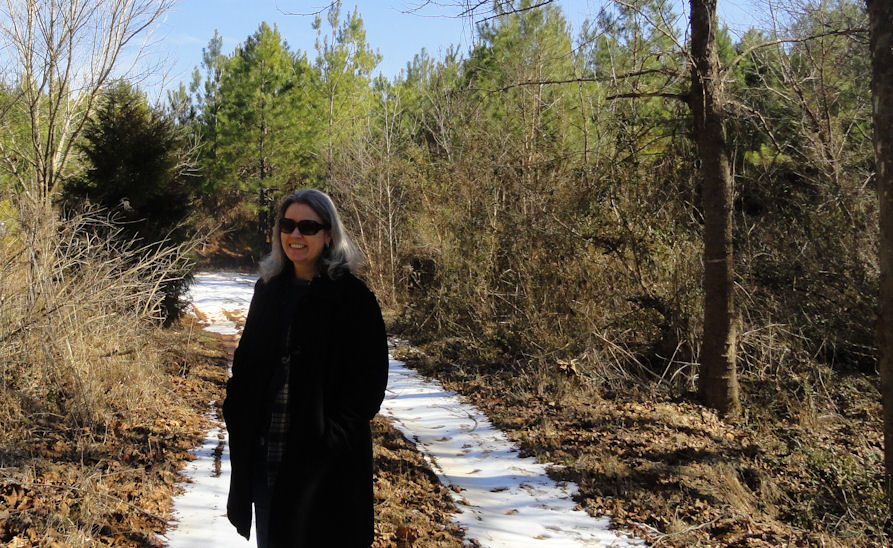
Went down to the forest farms. This is not the prettiest time to visit. In fact, it tends to be the ugliest time of the year. Lots of the plants are dead or brown. The pine trees are a little anemic; they will become much more brilliant green in a few months.
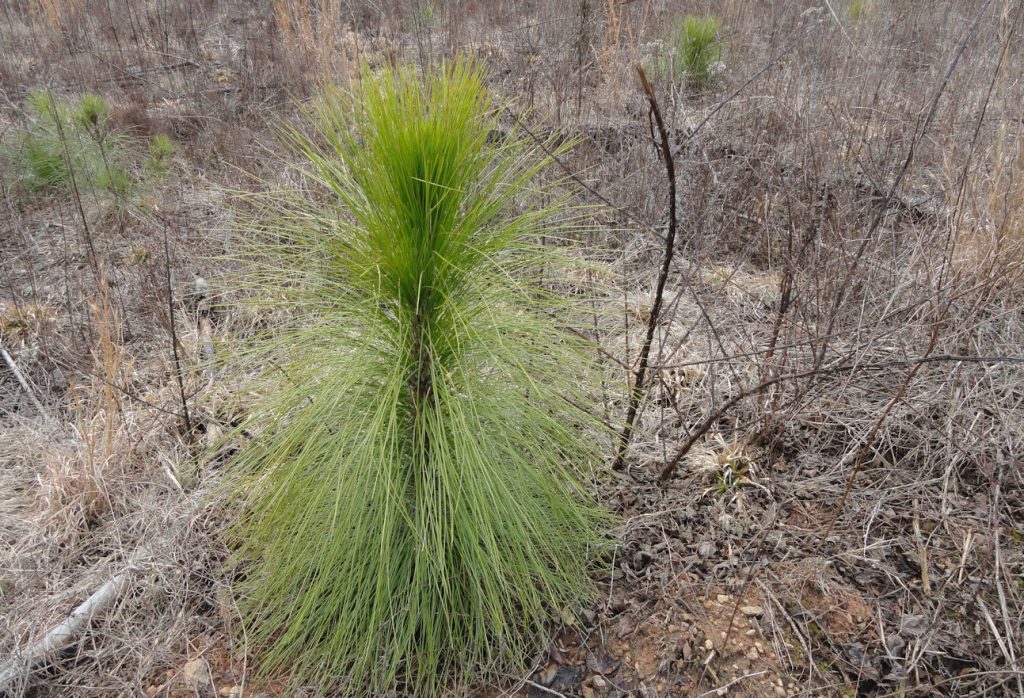
On the plus side, you can see better, since leaves and growing plants are not there to obscure. I was happy to see my longleaf pines are still there and doing okay. A few have really started to grow, as you see in the picture. Most are still in the “grass” stage.
They are building a big new natural gas fired generator near the Freeman place. They are going to expand the transmission lines and lay gas pipelines. It won’t affect my land directly, but I am not enthusiastic about any changes. I like things to stay in forestry. But I recognize that development happens and it is probably a good thing for many people. As I wrote in a earlier post, this part of Virginia is poor. My forests create few jobs. The gas generator will do better.
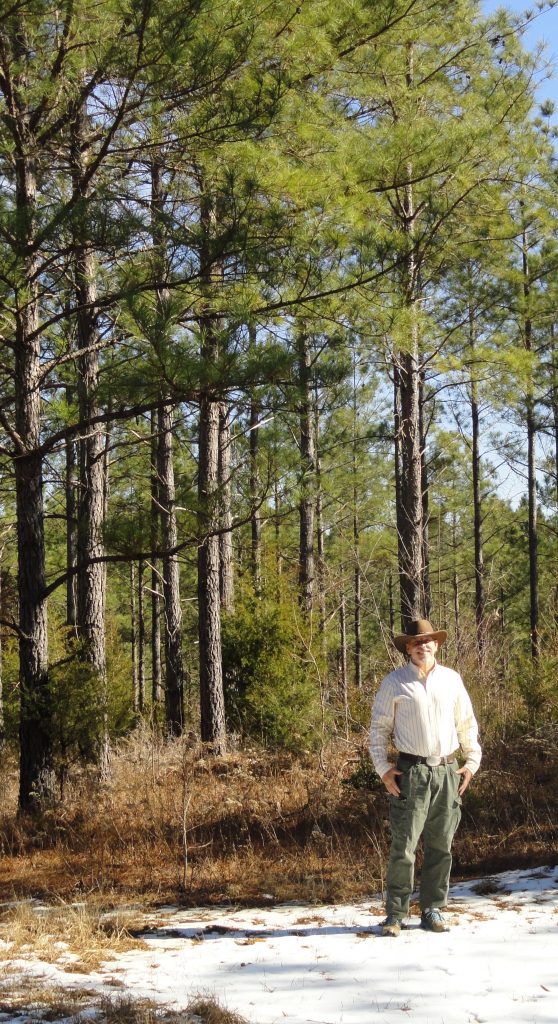
The top picture shows Chrissy on the CP forest road. Trees are getting bigger. Notice on the side of the road are sycamore trees. They grew by themselves, but I cut out the brush and thinned them into a nice colonnade. They are growing very rapidly. I am mildly allergic to sycamore. When I do a lot of cutting, I have to cough a lot.
The middle picture shows one of the longleaf pine seedlings. I doubt I will ever see this forest mature, but it will be magnificent. Longleaf used to be very common in the south. The State of Virginia is working on restoration. My five acres of longleaf are a drop in the bucket, but better than nothing. Below is me in the new forest. I think we will cut that this year or next and plant some genetically strong trees that will grow even faster and better.
The State of Virginia is now also advocating shortleaf pine restoration. I don’t know much about them, but I will see what I can find out. I want to have more diversity in my forests in order to make them more robust and useful for wildlife. I have to admit, however, that I really cannot identify a shortleaf pine. I may have some and not know it. I think they can hybridize with loblolly.
How the world has changed
The argument today is whether or not the U.S. should export oil. I continue to marvel at energy developments of the last ten years. The U.S. will soon be the world’s largest energy producer, an energy superpower. All the experience of the past forty years has been overtaken by events. It is the energy equivalent of the fall of the Berlin Wall and will have consequences as far reaching.
I should not be so surprised. I have been an optimist all my life, trusting that human imagination, intelligence and innovation can overcome all obstacles. But I came to maturity during the dark and cold days of the late 1970s, when President Carter told us that we would have to recognize limits, when books and movies emphasized the end of our resources. It is hard for me to believe that it is all so different.
When I was young, people around me made stuff out of raw materials. It seems perfectly intuitive that you could – would – run out of raw materials if you kept on making stuff. I remember hearing stories about the great range Mesabi Range in Minnesota just running out of iron ore. I pictured it just as empty. It was the end of the line. Those big iron ore boats coming through the lakes would come no more. I remember being a little surprised by the great song by Gordon Lightfoot about the wreck of the Edmund Fitzgerald in 1975. I thought those boats had mostly stopped already.
It seemed to make sense to see the world as a bunch of boxed filled with resources. Our ancestors had emptied lots of these boxes and we were emptying them even faster. Soon there would be no more full boxes and we would be out stuff and out of luck. This formulation is easy for child to understand, maybe because it is childish.
In real life, we have constantly developing technologies and techniques. We do indeed “run out” of some stuff, but by the time we do we have transitioned into something else, usually something that works better for our needs.
I recall my first class is business policy. We were assigned a well-known business and told to ask what business they were in. I was assigned McDonald’s and it seemed an easy answer. McDonald’s was in the hamburger business. This was the wrong answer. I expanded to fast-food. Still not right. I finally ended up with a vague “customer satisfaction” explanation. This was almost right, but still not broad enough. McDonald’s is in the customer satisfaction business, using mostly a fast and integrated process to do that. It is also in the logistics business, the technology business and the real estate business, among others. If people stopped eating hamburgers, McDonald’s would face challenges, but it would not necessarily go out of business, especially if the changes took place over some years. In fact, we have seen McDonald’s diversify its offerings since that time many years ago when I first gave my incorrect answer.
McDonald’s is just one firm. How much more adaptive is the great diversity of our society? I could have been asked a similar question about energy. Back in the 1970s, I might have talked about the need to secure foreign energy sources and to cut way back on energy consumption, maybe put on a sweater, turn down the lights and sit in the cold as President Carter implied. But things don’t really work like that.
So today we talk about how much energy we should export. The big energy producers in the world worry about the U.S. as a competitor. They can no longer ration our energy or use it against us. If they embargo oil to us, we don’t really care. In fact, the big geopolitical talk of today is whether or not we will ALLOW Iran to sell more oil. How the world has changed.
Orderly in its own peculiar way
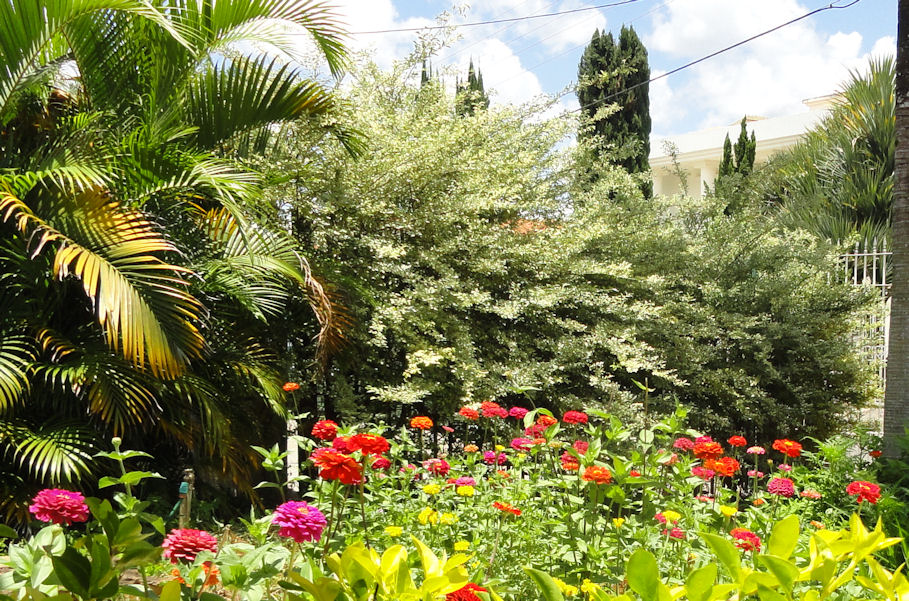
I don’t like things too orderly, at least not in the usual sense. I have to emphasize, not in the sense usually understood. I have been reading and studying for the last couple of years about randomness, chaos and spontaneous order. Most systems have an element of self-organization and all are subject to randomness. I am beginning to think that there is a higher order, a more subtle one but one more appropriate to the complex and changing situations we generally face. There is much we cannot control and it is probably better not to try. Instead of making plans that won’t work, it is better to have robust processes in place that take advantage of many situations. If you want to plan, maybe optimize it for the most likely scenario, but be ready to adapt.
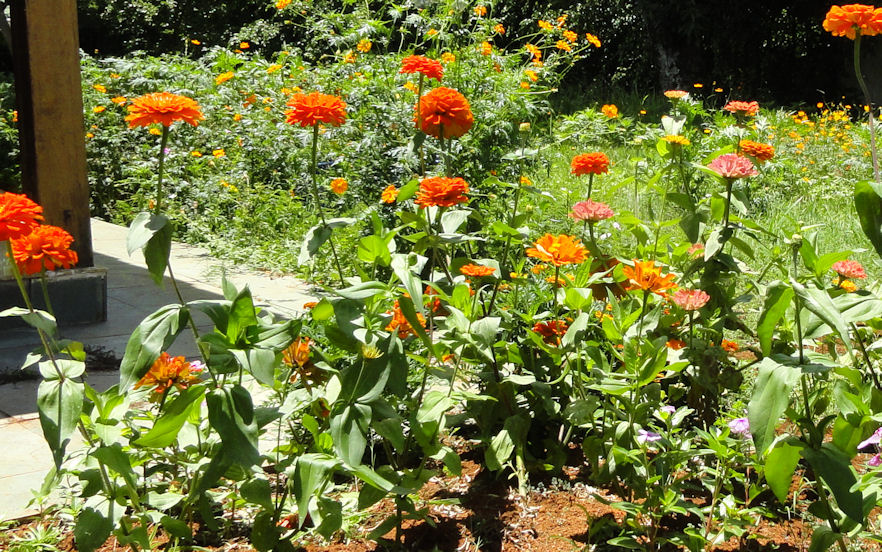
I have come to accept and even celebrate my ignorance, uncertainty and lack of detailed plans. It can be difficult to explain to others. I sometimes find it useful to have a profound plan that I can explain. Who knows? It might work. But I rarely believe that. I know with moral certitude that I will have to vary the plan, so it really is not a good idea to get too detailed into the planning. I suppose it is related to the “don’t spend a dollar to make a dime decision” rule of thumb. Don’t spend a lot of time and resources on something that is likely to be overtaken by events.
Things have been working out very well for me with my belief in the contingency nature of planning. I trust it will continue to work like that. People with plans seem to have things better in hand, but when those plans work it is merely a species of my random contingencies.

It doesn’t mean I don’t have any plans of my own, but I keep my goals firm and my methods flexible. IMO, some planners get this exactly wrong. They are less clear where they want to go than about the steps they will need to take to get there.
I was thinking about this today as I was weeding my “garden”. You can see the pictures of my flowers. It is disorderly in some senses, self-organizing and others and goal oriented for me. I pull weeds all the time and I move plants around. For example, I am establishing that ground cover you see with the blue flowers. Once in place, there will be no grass to cut in that place. The grass never grew very well there anyway. I have been gathering plants from other parts of the yard. The flowers come from seeds I gather when I ride my bike and then spread. They are all volunteers. I weed out what I don’t like, so it is not unplanned, but I do depend on what grows. My system is maintained w/o any power tools and I compost everything, so there is no garbage going out.
When I briefly had a gardener, we “exported” several bags of organic waste every week. I got rid of the gardener because he dissed by disorder and composting. I have not cut the whole lawn since May of 2012, although I knock down parts with my hand mover and scythe. There are lots of bees and butterflies and I suppose perhaps some of the nastier denizens of nature too, but they need a place to live too. The disorder gives us more diversity and more of everything in its disorder.
I think that is a good metaphor for life. It might be easier just to mow everything down, as it was when I got here. It would seem much more orderly, but it would be less interesting. Next week it will be different in ways I can anticipate but don’t control. I am always interested to see what will grow and how. I get to play in the garden every day and exert my influence, but there is the aspect of randomness. I like that. I established order in my peculiar way.
Know the place for the first time
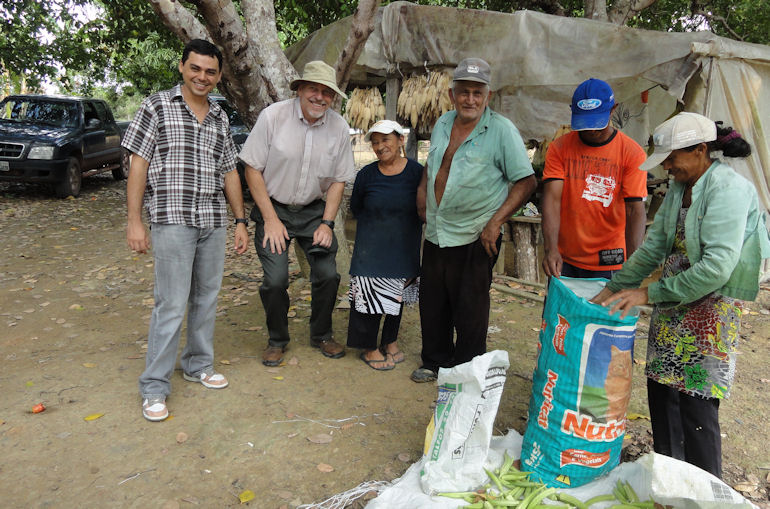
Many people would like to be farmers at five in the afternoon, but few want to be farmers at five in the morning. Farming is hard work and it was even harder work years ago. It is still hard work for many of the small farmers in the Amazon.
These guys, or their parents, came up the new Brasília to Belém highway thirty of forty years ago. They sometimes walked from places like Goiás of the Northeast looking for a new life in the new lands. Some made it big and there are a lot of productive large and modern farms on this Brazilian agricultural frontier. I talked to some of the smaller farmers.

Paragominas has a program that tries to help small farmers. The municipality guarantees that they will buy their produce for use in the schools, i.e. provides a certain market. But it is hard to keep them down on the farm and easy to understand why. It is hard work. The couple I talked to, the one you see in the picture above, were originally from the NE, I think they said from Ceará. They worked their whole lives on the farm, but their kids were college educated and unenthusiastic about keeping up the tradition of farming. Birth rates in Brazil are dropping and it seems likely that fewer and fewer farmers will be on the land as time goes on. This is probably good. More will be produced on fewer hectares.

I keep seeing parallels between American environmental history and what is happening today in Brazil. We are pioneer nations, taming the wilderness. It is out of style these days to tame the wilderness, but we have the luxury of it being out of style because we have tamed the wilderness. We cannot go back. Our challenge now is to adapt what we did to make it sustainable. Forests are growing back in the U.S. There are now more trees growing in Eastern North America than there were in 1776. Marginal lands have returned to forests and our agriculture is becoming sustainable. Brazil is on this path. We passed through the time of maximum destruction and we now it will begin to reverse. In the U.S., the nadir of forests was around 1920. Then things got better. I don’t know if Brazil has turned the corner yet, but it will soon.
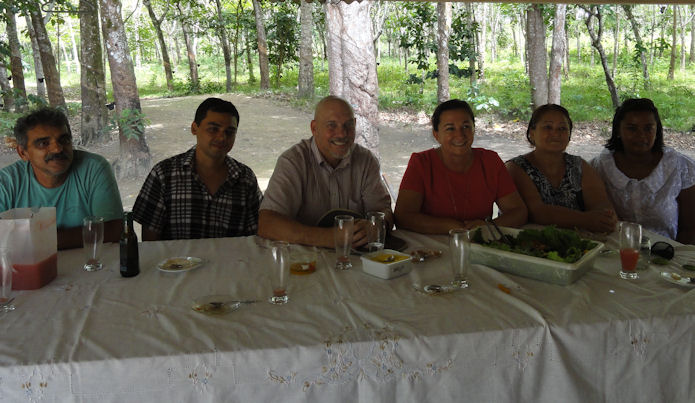
Sustainability sits on three pillars: environment, social and economic development. We often forget the last two when talking about sustainably, but in the long and medium run, w/o development in the social and economic spheres, the environment cannot be sustained. We humans do not properly understand the complexity of the environment and we never will. But sometimes we come close enough to truth to know some of the things we should do. We come around in circles. I recall the lines from TS Eliot, “We never stop exploring, and at the end of all our explorations we come back to where we started, and we will know that place for the first time”.
My pictures show some of the farmers. The pigs are an Amazon variety. You can see rubber trees tapped int he picture below and the supper picture is a great meal I had at one of the family farms, all with products growing locally and organically.
Family businesses in for the long run
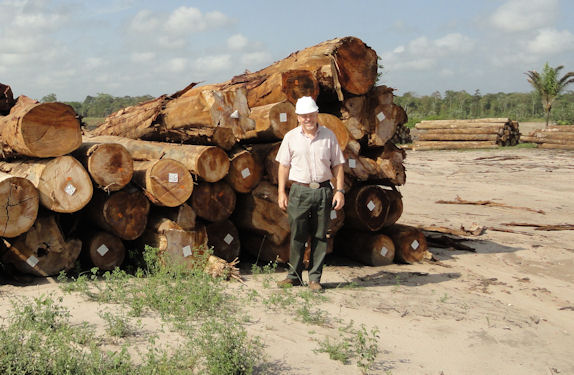
Many of the businesses around Paragominas are family owned, with generations of family members working there. The small sawmill in the picture above is family owned and so is the multimillion dollar wood processing and forestry operation farther down. I think this has to do with the pioneer nature of the society. The founders – or more likely today grandfathers – came to this place and set up shop. They have often gone through several cycles of business. There were shortages of people they could trust, with the proper skills to run the businesses, so they made their own.
The saw mill has been here for many years. The logs come up the river and are processed at this and other nearby mills in the town of São Miguel. All the logs processed here are certified. You can see the markings on each one. It is a specific number so the wood can be traced.

The Floraplac MDF plant is in a different business. They make fiberboard and wood products and require smaller trees that can be chipped and/or pulped. Originally, the factory used naturally occurring timber. But in the early 1990s, the owners saw that this would not be sustainable and started to plant their own. This created the need for different machines. Logs from the forest primeval tended to be big and differentiated. Those from plantations are smaller and uniform. The latter are easier to process, which is another benefit of plantation tree farming.
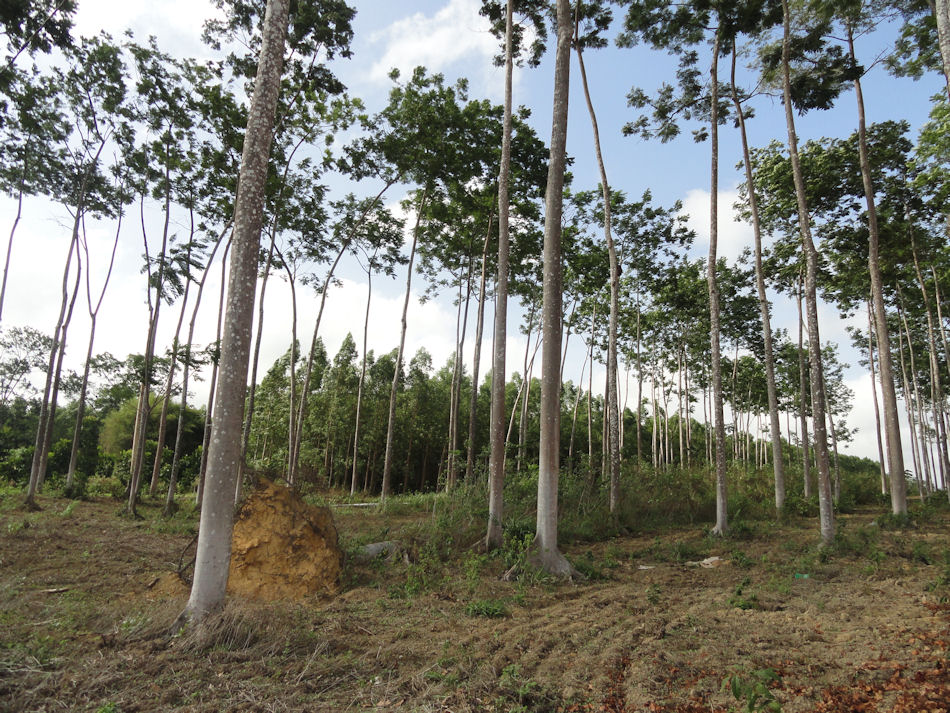
Some of the trees are a native Amazon species called paricá. This tree grows to harvest in around nine years. You can see the picture above. The wood is good and worth more per pound that eucalyptus, but eucalyptus produces more pounds per acre and has a shorter rotation of only seven years. There is need for both but the eucalyptus is often more useful, if less popular because of its non-native status.

There are hundreds of species of eucalyptus, so the variations are almost endless. Eucalyptus is native of Australia, but there are probably more types of the trees and more trees in Brazil than anyplace else in the world. Vitorio is constantly seeking to improve the genetic stock and silviculture of his trees. For example, some suffer from rot when there is too much humidity and they are now planting crossbred trees that are resistant. They are in a perpetual arms race with bugs and diseases. This is the way of nature, especially when you have large areas of very similar trees.
As I have written before, I am a little sad that eucalyptus has replaced pine over the warmer parts of Brazil. Pine is also an invasive species here, but it is familiar to me. I like the eucalyptus trees, but pine are more the woods of home. But where eucalyptus can grow well, pine cannot compete in the pulp & chip market. The eucalyptus has a nice scent, kind of a fresh mint. I still, however, prefer the pine.
Floraplac is a vertically integrated operation of a type we see increasingly rarely in the U.S. They own the land and grow the trees they use to supply their operation. During the 1990s anon most American pulp, paper and timber firms sold their land to smaller holders and timber investment management organizations (TIMOs). This is how I got my forest land. Companies figured that they did not have to bear the carrying costs and risks involved in growing the trees and owning the land. They could rely on private owners. The additional transaction costs were low compared to the carrying costs.
Brazil is not ready for this just yet. There are probably not enough private owners for all the land around here needed to supply the plant. I asked Vitorio about this model. He said that they are trying to source some timber from smaller holdings, but these were not people engaged in forestry, as they might be in the U.S. Rather they were doing a kind of silvopasture or woodland agriculture, where they would raise stock and/or crops among and between the trees. The forestry would provide a supplement to their income but not in itself be a viable investment.
Buying from small holders is not the most profitable business possible. Floraplac does it as part of its commitment to the community and corporate social responsibility. It is smart business in the long run. At some point in the future, there might be calls to move the plant or criticism of its use of forest resources. At the time, it will be good to have a significant group of people who better understand sustainable forestry and are connected by their own interests to the continued viability of the enterprise.
They were down to earth, friendly people. The multigenerational nature of the business ensures that they look to the future. It seems to me a really great business and an admirable business model, so far removed from the caricature of people showing up in the forest to make a quick buck and a quicker exit. People here are in it for the long run.
Belém to Brasília highway
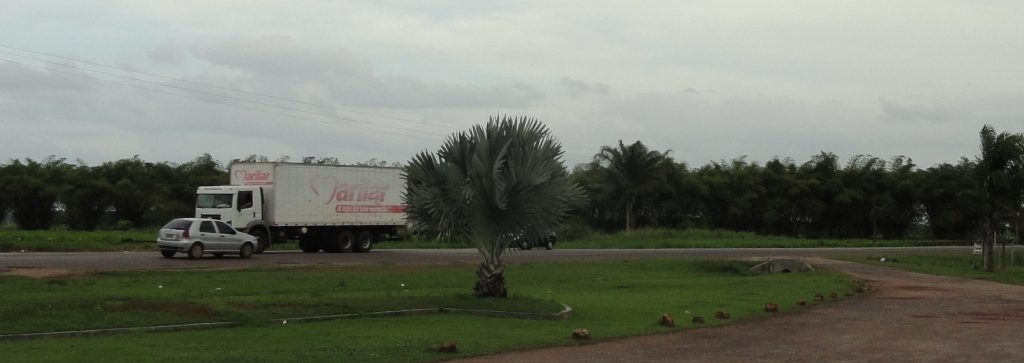
They started work more than fifty years ago. Today many people consider it a kind of mistake, maybe even a ecological disaster. After travelling along the road, I don’t agree. This is Brazil’s Route 66, a highway of dreams. The Brazilians at that time, led by President Juscelino Kubitschek, wanted to open up the empty land in the interior of Brazil. That is why he built Brasília and why he built the road to connect the new city of Brasília with the older city of Belém and with all the places in between.You can see a stretch of the road above
It was heroic work, cutting through what people at the time called jungle. Today we have a more politically correct term – rain forest. The people who did the work were pioneers, like those of the American west. They came to settle their country and seek a new life. It was hard and dangerous. Many people died in the process. Others are still there and they and their descendants are still there.
I learned that once the Amazon forest was cut, the soil would soon turn to rock and sand, unproductive. My observation is that this is not true. The soils are fertile and things grow wonderfully.
The land next to the Belém to Brasília highway has had three main and overlapping cycles. The first involved clearing the land and using the forest resources. This is very much like what happened in Wisconsin and Michigan in the 1850s and 1860s. It was disruptive, with forests being destroyed. Immigrants cleared the land and tried to establish farming. As with Wisconsin or Michigan, the success of the farmers was mixed. In some places, the soils and topography supported farming; other not so much.
The second stage consisted mostly of unsustainable cattle ranching. Ranchers put large numbers of cattle on the newly established pastures. There were not many animals per hectare. It was profitable for some, but very inefficient. This was the nadir stage. Things had been destroyed and degraded but not yet begun to renew. his was like Wisconsin in 1871, during the great Peshtigo fire that may have killed as many as 2500 people or the big blowout fire of 1910 that destroyed three million acres in Idaho, Montana and Washington and helped establish the need for the U.S Forest Service.
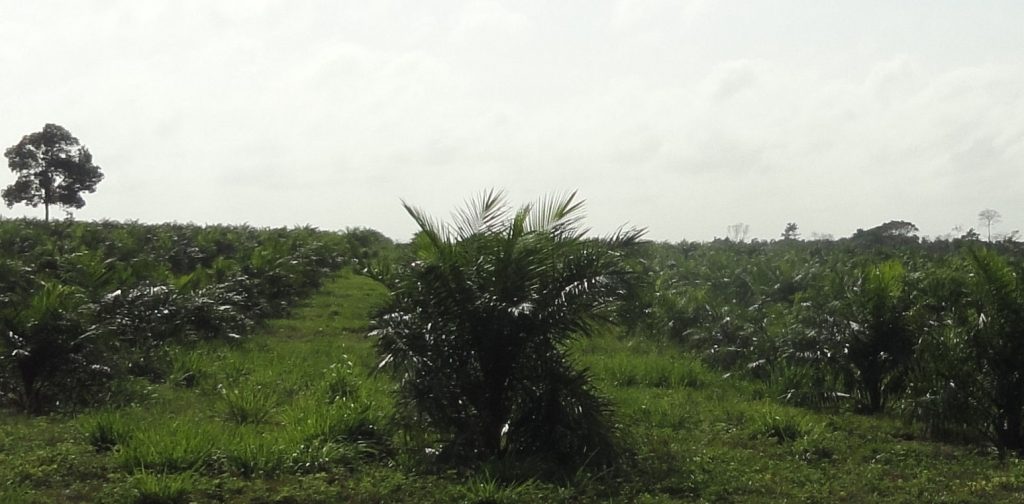
Cattle raising in the way they were doing was indeed unsustainable and that which is unsustainable will not be sustained. The region is now entering a third stage. This is the stage of readjustment and sustainability. As I have written elsewhere, sustainable does not mean natural. The ancient forests are gone, as are the ancient forests of Wisconsin. They will never return as they were, but that does not mean that the new systems are not sustainable. Above you can see an oil palm plantation newly established on a degraded pasture.
Cattle ranching remains an important part of the local economy, but it is becoming more efficient, with fewer hectares required to grow beef. Some of the degraded pasture is now available for crops and re-afforestation. This is exactly what happened in the U.S. a century ago. Paper and wood products mills are now mostly using fiber from planted trees, which I will talk about in subsequent posts. In the area around Paragominas, they grow soy. This is a triumph of the Brazilian USDA equivalent, EMBRAPA, which developed soy that growing in this tropical environment. A little farther north, where it rains more, they grow oil palm. You can see in my picture that oil palm is being planted in degraded pasture.
It is interesting what they have learned about micro-climates. The area around Paragominas has less rain than a hundred miles north. It still rains a lot, but less. Agriculture is sophisticated here, because they can plan for the rain. They have a regular rainy and dry season, like Brasília, but the dry season is not as dry and the wet season is even wetter.
Having my feet on this Amazonia ground gave me a different perception. It was also useful to come back thirty years later and see what had been done. I understand that there could be wildly different lesson learned. The natural forest is gone over much of the land. We can mourn the loss. On the other hand, it looks like it was been replaced with a sustainable system that supports human aspirations and endeavor.
I cannot help thinking back to my own home-place, with all its myths and realities. I grew to full adulthood in the forests of northern Wisconsin and that shaped my outlook. There are no “virgin” forests in Wisconsin. It was all cut over in the middle of the 19th Century and usually cut over and burned a few times after. Yet the forest is magnificent and sustainable. In many places you find stone walls and other evidence of old farms in the middle of old growth forests. Obviously, the people who tried to farm these thin soils gave up and moved away. But there is a human presence throughout in forestry, farming and cities. People live in and with nature. It is good.
This is what I see and wish for my Brazilian friends. They will look back at the extractive period in the same way we did. They will lament the loss, but appreciate the sacrifices and heroism of those who went before. This is the lesson good people will teach their children. They do already. I felt at home in the “tamed” Amazon in ways I never have in the “natural” parts. Human endeavor need not be destructive but it will lead to change, sometimes for the better.
One more thing about sustainable. Nothing lasts forever, not anything natural or man-made. We can strive for predictable and favorable change.
